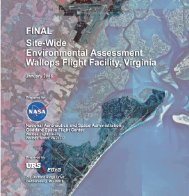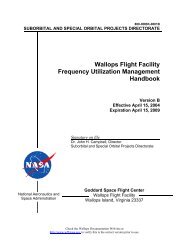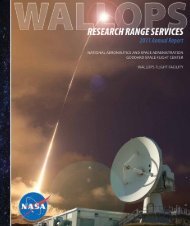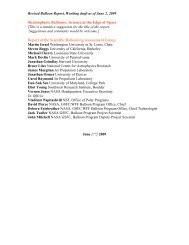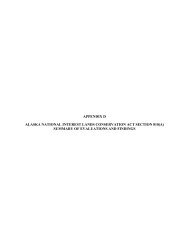Alternative Energy Draft EA - NASA Visitor Center at Wallops Flight ...
Alternative Energy Draft EA - NASA Visitor Center at Wallops Flight ...
Alternative Energy Draft EA - NASA Visitor Center at Wallops Flight ...
Create successful ePaper yourself
Turn your PDF publications into a flip-book with our unique Google optimized e-Paper software.
<strong>Altern<strong>at</strong>ive</strong> One<br />
Aboveground Resources<br />
Environmental Consequences<br />
Utility-scale turbines: Based on the analysis of impacts from the construction of two utility-scale<br />
turbines (described under the Proposed Action), <strong>NASA</strong> determined th<strong>at</strong> the construction of one<br />
utility-scale turbine on <strong>Wallops</strong> Island is not likely to have an adverse effect on aboveground<br />
historic properties within the 3.2-kilometer (2-mile) APE.<br />
Residential-scale turbines: Based on the analysis of impacts from the construction of the five<br />
residential-scale turbines (described the Proposed Action), it is not possible to determine whether<br />
historic properties are in the APE, or whether these properties may be directly or indirectly<br />
affected by the project component. However, there would be no demolition or alter<strong>at</strong>ion of<br />
buildings or structures for construction of the residential-scale wind turbines; therefore, the<br />
residential-scale wind turbines are not expected to have direct adverse effect to historic<br />
properties. Given the n<strong>at</strong>ure of the WFF facility, it is not likely th<strong>at</strong> the residential-scale wind<br />
turbines would have an indirect adverse effect on as-yet unidentified historic properties within<br />
the boundaries of WFF, if present. Indirect visual effects on historic properties outside of the<br />
WFF property cannot be determined <strong>at</strong> this time. Once the loc<strong>at</strong>ions of the residential-scale wind<br />
turbines are determined, <strong>NASA</strong> would consult with VDHR.<br />
Solar panels: Although the precise loc<strong>at</strong>ions of the solar panels are not yet known, <strong>NASA</strong> has<br />
indic<strong>at</strong>ed th<strong>at</strong> they would refer to the determin<strong>at</strong>ions of eligibility in the Historic Resources<br />
Survey and Eligibility Report for <strong>Wallops</strong> <strong>Flight</strong> Facility, Accomack County, Virginia (<strong>NASA</strong>,<br />
2004) and other formal determin<strong>at</strong>ions of eligibility to ensure th<strong>at</strong> solar panels are loc<strong>at</strong>ed only<br />
on or adjacent to resources found to be ineligible for listing in the NRHP. Therefore, it is not<br />
likely th<strong>at</strong> the install<strong>at</strong>ion of solar panels would have an adverse effect on aboveground historic<br />
properties, either identified or yet-to-be identified, within the boundaries of the WFF property.<br />
However, indirect visual effects to historic properties outside of the WFF Main Base cannot be<br />
determined <strong>at</strong> this time. Once the loc<strong>at</strong>ions of the solar panels are determined, <strong>NASA</strong> would<br />
consult with VDHR.<br />
Archaeological Resources<br />
According to the CRA assessment in 2003, the proposed loc<strong>at</strong>ion for the utility-scale turbine on<br />
<strong>Wallops</strong> Island is in an area mapped as low archaeological sensitivity. Although the loc<strong>at</strong>ions of<br />
the residential-scale turbines and solar panels are only generally known, <strong>NASA</strong> used the<br />
archaeological sensitivity model of the 2003 CRA (<strong>NASA</strong>, 2003a) to identify potential<br />
install<strong>at</strong>ion areas also having low archaeological probability (Figure 4 and Figure 5), thus<br />
avoiding install<strong>at</strong>ion of wind turbines and solar panels in areas of moder<strong>at</strong>e and high<br />
archaeological sensitivity. If unanticip<strong>at</strong>ed archaeological resources are identified during<br />
construction, the procedures outlined in the Integr<strong>at</strong>ed Cultural Resource Management Plan<br />
(<strong>NASA</strong>, 2006) would be followed to ensure compliance with Section 106 of the NHPA.<br />
133






